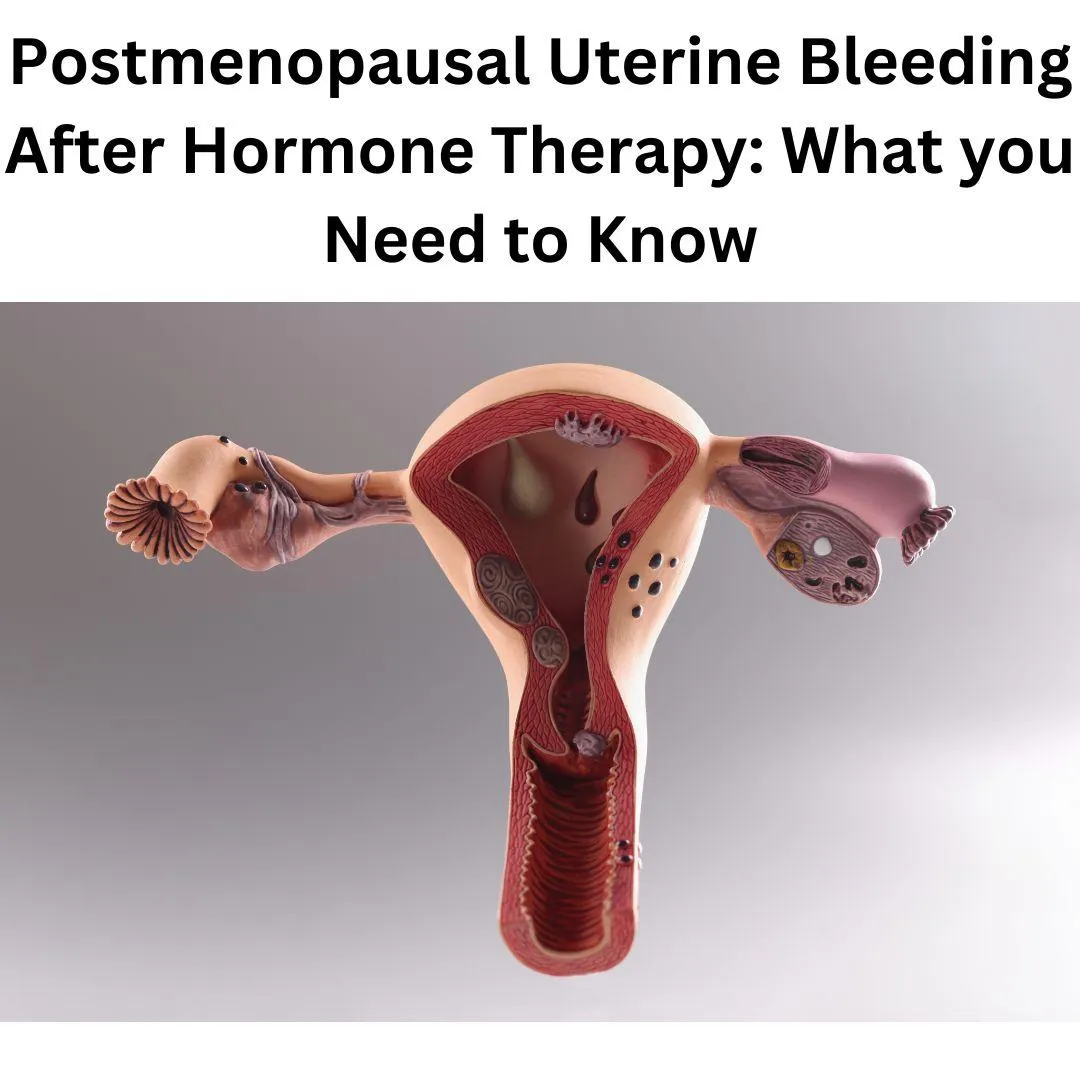*Open to Florida Residents
Blog
Blog

Postmenopausal Uterine Bleeding After Hormone Therapy: What You Need to Know
Postmenopausal uterine bleeding (PMB) is a common yet alarming symptom that affects many women in their later years. For women who have entered menopause defined as going 12 consecutive months without a menstrual period, the onset of vaginal bleeding can raise significant concerns. One of the most frequent scenarios that cause PMB is the use of hormone therapy to manage menopausal symptoms such as hot flashes, mood swings, and vaginal dryness. While hormone therapy can significantly improve the quality of life for many women, it can sometimes lead to unexpected side effects, including postmenopausal bleeding. This article explores the relationship between hormone therapy and postmenopausal uterine bleeding, the underlying causes, potential risks and available treatment options.
Understanding Menopause and Hormone Therapy
Menopause is a natural biological process that marks the end of a woman’s reproductive years and is defined as the cessation of menstruation for 12 consecutive months. Most women enter menopause between ages of 40 and 55, though it can occur earlier or later in some cases. Menopause occurs due to the decline of the ovaries production of hormones, specifically estrogen and progesterone. Two primary hormones that regulate the menstrual cycle. This hormonal shift leads to the end of the menstrual cycle, resulting in various physical and emotional symptoms. These can include:
Hot flashes
Night sweats
Mood changes
Sleep disturbances
Vaginal dryness and discomfort
Decreased libido
Bone density loss
To help manage these symptoms some women turn to hormone therapy. Hormone therapy involves the administration of estrogen or a combination of estrogen and progesterone to replenish the declining levels of these hormones in the body. There are two primary types of hormone therapy:
1. Estrogen Therapy: This is typically prescribed for women who have had a hysterectomy and no longer needed progesterone to protect against endometrial cancer.
2. Combined Estrogen –Progesterone Therapy: For women who still have their uterus, combined therapy is necessary to prevent the overgrowth of the endometrial lining, which could potentially lead to cancer.
Hormone therapy can be delivered via oral tablets, skin patches, vaginal creams, gels, and rings, depending on a woman’s specific symptoms and medical history.
While hormone therapy is generally effective in alleviating menopausal symptoms, it is not without risks and complications. One of the side effects that some women experience is postmenopausal uterine bleeding, which can occur for a variety of reasons. In general, vaginal bleeding after menopause is not considered normal and should always be evaluated by a healthcare provider. While many cases may be benign, postmenopausal bleeding can sometimes be a sign of serious conditions, including endometrial cancer. Early diagnosis of any underlying condition is key to appropriate management.
Causes of Postmenopausal Uterine Bleeding
Endometrial Atrophy: As estrogen levels drop, the lining of the uterus may become thin and fragile, causing light bleeding.
Endometrial Hyperplasia: In some cases, hormone imbalances may cause the uterine lining to thicken excessively, leading to bleeding and increasing the risk of endometrial cancer.
Polyps: Benign growths in the uterine or cervical lining can cause postmenopausal bleeding.
Endometrial Cancer: Although less common, bleeding can sometimes be a sign of cancer in the lining of the uterus.
Other Gynecological Issues: Cervical or vaginal infections, fibroids, or trauma can also lead to postmenopausal bleeding.
How Hormone Therapy Can Lead to Uterine Bleeding
Effects of Estrogen on the Uterine Lining:
Estrogen is essential in maintaining the thickness and health of the endometrial lining during a woman’s reproductive years. After menopause, the decline in estrogen causes the endometrial lining to thin and eventually stop shedding. However, when estrogen is reintroduced through hormone therapy, it can stimulate the growth of the endometrial lining.
In women who are on estrogen-only therapy, this unopposed estrogen can lead to excessive growth of the uterine lining, also known as endometrial hyperplasia. This thickening can result in abnormal uterine bleeding. Combination hormone therapy, estrogen and progesterone, is designed to reduce the risk by preventing the overgrowth of the uterine lining, but bleeding can still occur as a side effect.
One of the most pressing concerns when a postmenopausal woman experiences uterine bleeding is the potential for endometrial cancer. Endometrial cancer is the most common type of uterine cancer and typically presents with abnormal uterine bleeding. The risk of developing endometrial cancer increases with age and other factors, including obesity, use of estrogen without progesterone, and a history of endometrial hyperplasia. Hormone therapy can also affect a woman’s risk of endometrial cancer. Estrogen stimulates the growth of the endometrial lining, which is why progesterone is included in hormone therapy for women with an intact uterus.
Types of Hormone Therapy and Their impact on Bleeding
Cyclic Hormone Therapy: In cyclic hormone therapy, estrogen is given continuously, while progesterone is added for part of the month, usually days 12 to 14. During the progesterone phase, the uterine lining is shed, much like a menstrual period, and this can result in light bleeding or spotting.
Continuous Combined Therapy: In this regimen, both estrogen and progesterone are given together continuously. Some women may experience light bleeding or spotting within the first six months as the body adjusts to the hormones. After this adjustment period, bleeding usually subsides.
Estrogen-Only Therapy: In women who have had a hysterectomy, estrogen alone may be sufficient, as there is no risk of endometrial hyperplasia. However, if a woman with an intact uterus receives estrogen-only therapy, it can lead to significant thickening of the uterine lining, increasing the risk of bleeding and endometrial cancer.
Evaluation and Diagnosis of Postmenopausal Uterine Bleeding
When a woman on hormone therapy experiences postmenopausal bleeding, the first step is to consult a healthcare provider. The evaluation process typically involves several steps:
Medical History and Physical Examination: The doctor will review your medical history, including the type of hormone therapy being used and any risk factors for endometrial cancer. A pelvic examination may also be performed to assess the reproductive organs.
Transvaginal Ultrasound: This imaging test uses sound waves to create pictures of the uterus and ovaries. It can help measure the thickness of the endometrial lining. In postmenopausal women, the endometrium is typically less than 4-5mm. A thicker endometrial lining may warrant further investigation, such as a biopsy.
Endometrial Biopsy: A small sample of the endometrial tissue is removed and examined under a microscope to check for abnormal cells or cancer. This is a quick outpatient procedure and is considered the gold standard for diagnosing endometrial cancer.
Hysteroscopy: In some cases, a hysteroscopy may be performed, allowing the doctor to view the inside of the uterus using a thin, lighted tube. This procedure can help identify polyps, fibroids, or other abnormalities.
Dilation and Curettage (D&C): This procedure may be recommended if other tests are inconclusive. It involves scraping the uterine lining to remove tissue for further analysis.
Management and Treatment Options
Once the underlying cause of postmenopausal uterine bleeding has been determined, treatment can be tailored accordingly. If the bleeding is related to hormone therapy several options may be considered:
Adjustment of Hormone Therapy: For women on cyclic hormone therapy, switching to a continuous combined regimen may help reduce bleeding. In some cases, lowering the dose of estrogen or switching to a different form of hormone therapy, such as patch, cream, gel, can also alleviate symptoms.
Progesterone Therapy: If a woman is on estrogen only therapy and experiences bleeding adding a progesterone can help regulate the endometrial lining and prevent further bleeding. This may involve taking a progesterone pill or using a progesterone cream vaginally.
Endometrial Ablation: in cases of persistent bleeding, a procedure to destroy the endometrial lining may be recommended. This can reduce or eliminate bleeding but may also affect future fertility.
Hysterectomy: In cases of recurrent hyperplasia, significant fibroids, or endometrial cancer, removal of the uterus may be recommended.
When (should you) to Seek Medical Attention
Any postmenopausal bleeding, especially when it occurs after starting hormone therapy, should be promptly evaluated by a healthcare provider. Women should seek medical attention if they experience:
Heavy or prolonged bleeding
Bleeding that occurs more than six months after starting hormone therapy
Bleeding accompanied by other symptoms such as pelvic pain or pressure
Recurrent or persistent spotting that does not resolve with adjustments to hormone therapy.
Conclusion: Women need to Understand the Risk and Benefits of Hormone Therapy
Postmenopausal uterine bleeding can be an unsettling experience, but it is not uncommon, especially in women undergoing hormone therapy. While bleeding may result from hormone related changes in the uterine lining, it is crucial to rule out more serious causes such as endometrial hyperplasia or cancer.
For women considering or currently undergoing hormone therapy, understanding the potential side effects and complications is key to managing your health. Regular monitoring and open communication with a healthcare provider can help ensure that any issues, including abnormal bleeding are addressed promptly.
While hormone therapy can offer significant relief from menopausal symptoms, its use should always be individualized based on a woman’s health history, symptoms, and risk factors. By working closely with a healthcare provider, you can make informed decisions and minimize the risks associated with hormone therapy, ensuring you maintain your health and quality of life during the postmenopausal years.

Postmenopausal Uterine Bleeding After Hormone Therapy: What You Need to Know
Postmenopausal uterine bleeding (PMB) is a common yet alarming symptom that affects many women in their later years. For women who have entered menopause defined as going 12 consecutive months without a menstrual period, the onset of vaginal bleeding can raise significant concerns. One of the most frequent scenarios that cause PMB is the use of hormone therapy to manage menopausal symptoms such as hot flashes, mood swings, and vaginal dryness. While hormone therapy can significantly improve the quality of life for many women, it can sometimes lead to unexpected side effects, including postmenopausal bleeding. This article explores the relationship between hormone therapy and postmenopausal uterine bleeding, the underlying causes, potential risks and available treatment options.
Understanding Menopause and Hormone Therapy
Menopause is a natural biological process that marks the end of a woman’s reproductive years and is defined as the cessation of menstruation for 12 consecutive months. Most women enter menopause between ages of 40 and 55, though it can occur earlier or later in some cases. Menopause occurs due to the decline of the ovaries production of hormones, specifically estrogen and progesterone. Two primary hormones that regulate the menstrual cycle. This hormonal shift leads to the end of the menstrual cycle, resulting in various physical and emotional symptoms. These can include:
Hot flashes
Night sweats
Mood changes
Sleep disturbances
Vaginal dryness and discomfort
Decreased libido
Bone density loss
To help manage these symptoms some women turn to hormone therapy. Hormone therapy involves the administration of estrogen or a combination of estrogen and progesterone to replenish the declining levels of these hormones in the body. There are two primary types of hormone therapy:
1. Estrogen Therapy: This is typically prescribed for women who have had a hysterectomy and no longer needed progesterone to protect against endometrial cancer.
2. Combined Estrogen –Progesterone Therapy: For women who still have their uterus, combined therapy is necessary to prevent the overgrowth of the endometrial lining, which could potentially lead to cancer.
Hormone therapy can be delivered via oral tablets, skin patches, vaginal creams, gels, and rings, depending on a woman’s specific symptoms and medical history.
While hormone therapy is generally effective in alleviating menopausal symptoms, it is not without risks and complications. One of the side effects that some women experience is postmenopausal uterine bleeding, which can occur for a variety of reasons. In general, vaginal bleeding after menopause is not considered normal and should always be evaluated by a healthcare provider. While many cases may be benign, postmenopausal bleeding can sometimes be a sign of serious conditions, including endometrial cancer. Early diagnosis of any underlying condition is key to appropriate management.
Causes of Postmenopausal Uterine Bleeding
Endometrial Atrophy: As estrogen levels drop, the lining of the uterus may become thin and fragile, causing light bleeding.
Endometrial Hyperplasia: In some cases, hormone imbalances may cause the uterine lining to thicken excessively, leading to bleeding and increasing the risk of endometrial cancer.
Polyps: Benign growths in the uterine or cervical lining can cause postmenopausal bleeding.
Endometrial Cancer: Although less common, bleeding can sometimes be a sign of cancer in the lining of the uterus.
Other Gynecological Issues: Cervical or vaginal infections, fibroids, or trauma can also lead to postmenopausal bleeding.
How Hormone Therapy Can Lead to Uterine Bleeding
Effects of Estrogen on the Uterine Lining:
Estrogen is essential in maintaining the thickness and health of the endometrial lining during a woman’s reproductive years. After menopause, the decline in estrogen causes the endometrial lining to thin and eventually stop shedding. However, when estrogen is reintroduced through hormone therapy, it can stimulate the growth of the endometrial lining.
In women who are on estrogen-only therapy, this unopposed estrogen can lead to excessive growth of the uterine lining, also known as endometrial hyperplasia. This thickening can result in abnormal uterine bleeding. Combination hormone therapy, estrogen and progesterone, is designed to reduce the risk by preventing the overgrowth of the uterine lining, but bleeding can still occur as a side effect.
One of the most pressing concerns when a postmenopausal woman experiences uterine bleeding is the potential for endometrial cancer. Endometrial cancer is the most common type of uterine cancer and typically presents with abnormal uterine bleeding. The risk of developing endometrial cancer increases with age and other factors, including obesity, use of estrogen without progesterone, and a history of endometrial hyperplasia. Hormone therapy can also affect a woman’s risk of endometrial cancer. Estrogen stimulates the growth of the endometrial lining, which is why progesterone is included in hormone therapy for women with an intact uterus.
Types of Hormone Therapy and Their impact on Bleeding
Cyclic Hormone Therapy: In cyclic hormone therapy, estrogen is given continuously, while progesterone is added for part of the month, usually days 12 to 14. During the progesterone phase, the uterine lining is shed, much like a menstrual period, and this can result in light bleeding or spotting.
Continuous Combined Therapy: In this regimen, both estrogen and progesterone are given together continuously. Some women may experience light bleeding or spotting within the first six months as the body adjusts to the hormones. After this adjustment period, bleeding usually subsides.
Estrogen-Only Therapy: In women who have had a hysterectomy, estrogen alone may be sufficient, as there is no risk of endometrial hyperplasia. However, if a woman with an intact uterus receives estrogen-only therapy, it can lead to significant thickening of the uterine lining, increasing the risk of bleeding and endometrial cancer.
Evaluation and Diagnosis of Postmenopausal Uterine Bleeding
When a woman on hormone therapy experiences postmenopausal bleeding, the first step is to consult a healthcare provider. The evaluation process typically involves several steps:
Medical History and Physical Examination: The doctor will review your medical history, including the type of hormone therapy being used and any risk factors for endometrial cancer. A pelvic examination may also be performed to assess the reproductive organs.
Transvaginal Ultrasound: This imaging test uses sound waves to create pictures of the uterus and ovaries. It can help measure the thickness of the endometrial lining. In postmenopausal women, the endometrium is typically less than 4-5mm. A thicker endometrial lining may warrant further investigation, such as a biopsy.
Endometrial Biopsy: A small sample of the endometrial tissue is removed and examined under a microscope to check for abnormal cells or cancer. This is a quick outpatient procedure and is considered the gold standard for diagnosing endometrial cancer.
Hysteroscopy: In some cases, a hysteroscopy may be performed, allowing the doctor to view the inside of the uterus using a thin, lighted tube. This procedure can help identify polyps, fibroids, or other abnormalities.
Dilation and Curettage (D&C): This procedure may be recommended if other tests are inconclusive. It involves scraping the uterine lining to remove tissue for further analysis.
Management and Treatment Options
Once the underlying cause of postmenopausal uterine bleeding has been determined, treatment can be tailored accordingly. If the bleeding is related to hormone therapy several options may be considered:
Adjustment of Hormone Therapy: For women on cyclic hormone therapy, switching to a continuous combined regimen may help reduce bleeding. In some cases, lowering the dose of estrogen or switching to a different form of hormone therapy, such as patch, cream, gel, can also alleviate symptoms.
Progesterone Therapy: If a woman is on estrogen only therapy and experiences bleeding adding a progesterone can help regulate the endometrial lining and prevent further bleeding. This may involve taking a progesterone pill or using a progesterone cream vaginally.
Endometrial Ablation: in cases of persistent bleeding, a procedure to destroy the endometrial lining may be recommended. This can reduce or eliminate bleeding but may also affect future fertility.
Hysterectomy: In cases of recurrent hyperplasia, significant fibroids, or endometrial cancer, removal of the uterus may be recommended.
When (should you) to Seek Medical Attention
Any postmenopausal bleeding, especially when it occurs after starting hormone therapy, should be promptly evaluated by a healthcare provider. Women should seek medical attention if they experience:
Heavy or prolonged bleeding
Bleeding that occurs more than six months after starting hormone therapy
Bleeding accompanied by other symptoms such as pelvic pain or pressure
Recurrent or persistent spotting that does not resolve with adjustments to hormone therapy.
Conclusion: Women need to Understand the Risk and Benefits of Hormone Therapy
Postmenopausal uterine bleeding can be an unsettling experience, but it is not uncommon, especially in women undergoing hormone therapy. While bleeding may result from hormone related changes in the uterine lining, it is crucial to rule out more serious causes such as endometrial hyperplasia or cancer.
For women considering or currently undergoing hormone therapy, understanding the potential side effects and complications is key to managing your health. Regular monitoring and open communication with a healthcare provider can help ensure that any issues, including abnormal bleeding are addressed promptly.
While hormone therapy can offer significant relief from menopausal symptoms, its use should always be individualized based on a woman’s health history, symptoms, and risk factors. By working closely with a healthcare provider, you can make informed decisions and minimize the risks associated with hormone therapy, ensuring you maintain your health and quality of life during the postmenopausal years.
Let me help you achieve your goals.
Disclaimer: We understand that every individual's experience is unique and results may vary depending on various factors, such as attitude, adaptability, personal history, and overall health. For your safety and well-being, we highly recommend consulting your physician before beginning any program. At Elite Sexual Hormone Health, we do not diagnose, treat, or prescribe any medical or psychological disorders. We urge you to seek the care of a qualified physician or psychotherapist if you suffer from any psychological or medical disorder. Thank you for choosing Elite Sexual Hormone Health as your partner in your journey towards wellness.
© 2025, Elite Sexual Hormone Health. All rights reserved.
Privacy Policy | Terms of Service | Disclaimer
© 2025, Elite Sexual Hormone Health. All rights reserved.
Website by Hypnotherapy Accelerator





